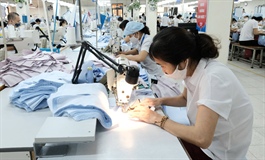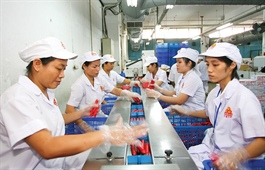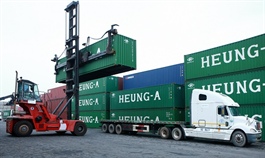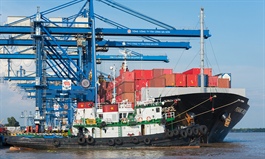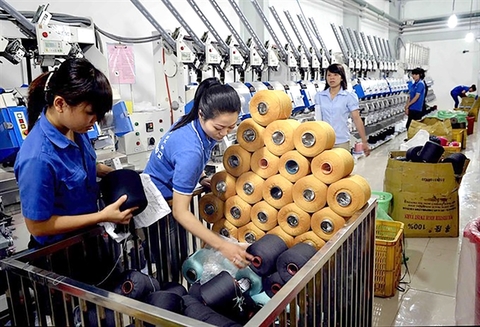FDI reality stunting south’s regional improvement
FDI reality stunting south’s regional improvement
Lacking completed and synchronised transport infrastructure, as well as shortcomings in both education and healthcare, is the main reason for lowered attractiveness in Vietnam’s Southern Key Economic Region for financiers.

Pham Tran Hai
|
Prime Minister Nguyen Xuan Phuc last week attended the inaugural ceremony of the Phuoc Dong Industrial Zone and Port in the Mekong Delta province of Long An. The industrial zone is located in the Southern Key Economic Region (KER) and is expected to serve as a magnet to lure investors.
However, it was an expectation only. In reality, this region is facing numerous difficulties in developing socioeconomically as well as in attracting foreign direct investment (FDI).
In general, economic growth is not high and lacks sustainability, while the shifting in economic structure is slow. The ratio between the three sectors of agro-forestry-fishery, construction-industry, and services in 2015 was 38, 26, and 31 per cent respectively, while in 2019 the ratio was 31, 33, and 30 per cent, respectively, with balanced out results across the board suggesting a lack of advancement.
The region has yet to attract large-scale FDI. The average capital per project is $10 million, which is $2.42 million lower than the average figure of the whole country. In Ho Chi Minh City, the average investment capital per project is $5.56 million, equalling 44.7 per cent compared to the average scale of the whole country.
The main reason for this is that the infrastructure system has yet to keep up with the needs of socioeconomic development of the region. Traffic jams are by far the most serious congestion point for the region, and which takes place on road, in the air, and on sea routes.
Traffic congestion occurs on almost all national roadway and inner roads, especially the surrounding area of Tan Son Nhat International Airport and seaport clusters in Ho Chi Minh City. Meanwhile, the seaport cluster in the city is considered the region’s gateway and make up 67 per cent of the capacity of the country’s entire seaport system.
In addition, overload in almost all schools and training facilities as well as medical examination and treatment facilities in the region, and Ho Chi Minh City in particular, is a barrier for investors as well as experts to arrive in the region to work and live.
Lack of mechanisms to coordinate economic benefits among localities in the region causes ineffectiveness in regional links. Localities have yet to thoroughly take the region’s particular advantages and take advantage of mutual development among members.
Furthermore, activities to attract investment and boost economic links have not taken place on a large scale. Linking industry clusters or sharing important technical and social infrastructure has also not been focused enough.
At present, the region is home to numerous industrial parks (IZs) including Bien Hoa, Nhon Trach, Loteco, Amata Dong Nai, and VSIP Binh Duong. However these IZs, which operate effectively, account for only a small ratio compared to the total numbers of IZs in the region.
The ratio of IZs operating in the southern KER accounts for 65 per cent of the total IZs across the country. However, the attractiveness of these IZs has decreased because of weaknesses in developing infrastructure as well as lack of mechanisms to coordinate economic benefits among localities.
During the process to promote socioeconomic development, localities in the southern KER are facing two major problems.
The first one is having to promote innovation and creativity, and adapt to economic development requirements in the context of Industry 4.0, while also having to ensure compliance with legal regulations. The second issue is how to strengthen cooperation for the common development of the region and each locality.
From reviewing these realities in the KER, in order to promote the overall development it is important to have effective solutions to clear these bottlenecks. It is necessary to synchronise the framework infrastructure system, which consists of important arteries for connection between localities in the region.
In the implementation of any solution, it is necessary to ensure consistency and integrity. If the problem of coordination of economic benefits between localities in regional links is resolved, the implementation of investment in infrastructure in the region also becomes easier.
Localities should regularly review, adjust, and supplement appropriate policies to meet the demand on developing socioeconomic growth. Besides that, the southern KER needs to accelerate the preparation, appraisal, and approval of regional and provincial plans. The delay in these works is one of the reasons for disrupting or slowing down the process of regional socioeconomic development and regional integration, as well as the development of each province in particular.
The content of regional planning should clearly highlight what key industries and areas need to link, as well as the roles, duties, and responsibilities of each relevant authority – especially the responsibilities of each locality in regional planning. For regional planning, it is necessary to determine power resources in planning and allocate sufficient resources in the process of implementing the plan, especially financial resources.
Attracting “eagles” to the nest is a necessary factor for the all KERs in the coming time but it is necessary to have a mechanism that is attractive enough to attract large-scale joint ventures between foreign and domestic investors in order to ensure that overseas investment is more meaningful and sustainable.
At present, Ho Chi Minh City boasts over 90 per cent of foreign-invested enterprises; however, the figure from 2019 showed that less than 10 per cent of them are joint ventures, accounting for 15 per cent of the whole foreign investment capital of the city. This reality causes limits in terms of the ability to learn and absorb experiences from other countries for domestic businesses, especially in technology transfer and business methods.







